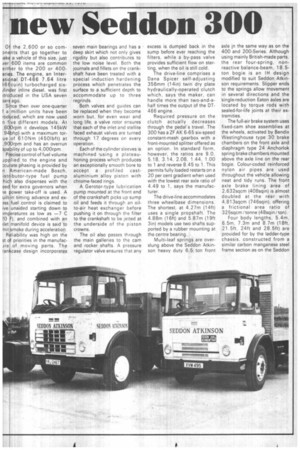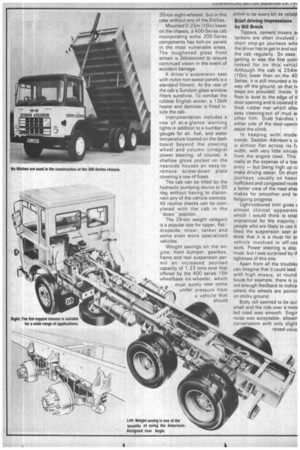new Seddon 300
Page 51

Page 52

If you've noticed an error in this article please click here to report it so we can fix it.
01 the 2,600 or so cornonents that go together to lak€ a vehicle of this size, just ifer 600 items are common either to the 200 or 400eries. The engine, an Interaticnal DT-466 7.64 litre 1-6Ecuin) turbocharged sixflinder inline diesel, was first 'traduced in the USA seven ?,ars ago.
Since then over one-quarter f a million units have been roduced, which are now used n f ve different models. At ,600rpm it develops 145kW 94bhp) with a maximum torue of 610Nm (450Ibft) at ,900rpm and has an overrun 3papility of up to 4,000rpm. Precise control of fuel volume applied to the engine and :cu -ate phasing is provided by n American-made Bosch, istributor-type fuel pump rhici also dispenses with the eed for extra governors when le power take-off is used. A uilt-in timing advance and ex3SS fuel control is claimed to ive unaided starting down to rriceratures as low as —7 C .N;) F), and combined with an ilet manifold device is said to mit smoke during acceleration. Reliability was high on the st of priorities in the manufacire of moving parts. The rankcase design incorporates
seven main bearings and has a deep skirt which not only gives rigidity but also contributes to the low noise level, Both the journals and fillets on the crankshaft have been treated with a special induction hardening process which penetrates the surface to a sufficient depth to accommodate up to three regrinds.
Both valves and guides can be replaced when they become worn but. for even wear and long life, a valve rotor ensures that each of the inlet and stellite faced exhaust valves are turned through 17 degrees on every operation.
Each of the cylinder sleeves is machined -using a plateauhoning process which produces an exceptionally smooth bore to accept a profiled castaluminium alloy piston with chrome-faced rings.
A Gerotor-type lubrication pump mounted at the front end of the crankshaft picks up sump oil and feeds it through an oilto-air heat exchanger before pushing it on through the filter to the crankshaft to be jetted at the underside of the piston crowns.
The oil also passes through the main galleries to the cam and rocker shafts. A pressure regulator valve ensures that any excess is dumped back in the sump before ever reaching the filters, while a by-pass valve provides sufficient flow on starting, when the oil is still cold.
The drive-line comprises a Dana Spicer self-adjusting 356mm (14in) twin dry plate hydraulically-operated clutch which, says the maker, can handle more than two-and-ahalf times the output of the DT466 engine.
'Required pressure on the clutch actually decreases through the pedal's travel. The 300 has a ZF AK 6-65 six-speed constant-mesh gearbox with a front-mounted splitter offered as an option. In standard form, however, the ratios are 9.0, 5.18, 3.14, 2.08, 1.44, 1.00 to 1 and reverse 8.45 to 1. This permits fully loaded restarts on a 20 per cent gradient when used with the lowest rear axle ratio of 4,49 to 1, says the manufacturer.
The drive-line accommodates three wheelbase dimensions. The shortest, at 4.27m (14ft) uses a single propshaft. The 4.88m (16ft) and 5.87m (19ft 3in) models use two shafts supported by a rubber mounting at the centre bearing.
Multi-leaf springs are overslung above the Seddon Atkinson heavy duty 6.5 ton front axle in the same way as on the 400 and 200-Series. Although using mainly British-made parts, the rear four-spring, nonreactive balance-beam, 18.5ton bogie is an IH design modified to suit Seddon Atkinson requirements. Slipper ends to the springs allow movement in several directions and the Single-reduction Eaton axles are located by torque rods with sealed-for-life joints at their extremities.
The full-air brake system uses fixed-cam shoe assemblies at the wheels, activated by Bendix Westinghouse type 30 brake chambers on the front axle and diaphragm type 24 Anchorlok spring brake chambers mounted above the axle line on the rear bogie. Colour-coded reinforced nylon air pipes are used throughout the vehicle allowing neat and tidy runs. The front axle brake lining area of 2,632sqcm (408sqin) is almost doubled at the rear with 4,813sqcm (746sqin), offering a frictional area ratio of 325sqcm /tonne (48sqin /ton).
Four body lengths, 5.4m, 6.5m, 7.3m and 8.7m (18ft, 21.5ft, 24ft and 28.5ft) are provided for by the ladder-type chassis, constructed from a similar carbon manganese steel frame section as on the Seddon 30-ton eight-wheeler, but in this case without any of the flitches.
Mounted 0.25m (10in) lower on the chassis, a 400-Series cab incorporating some 200-Series components has bolt-on panels in the most vulnerable areas. The toughened glass front screen is Zebrazoned to ensure continued vision in the event of accident damage.
A driver's suspension seat with nylon non-sweat panels is a standard fitment. At the rear of the cab a Sundym glass window filters sunshine. To combat the coldest English winter, a 12kW heater and demister is fitted inside the cab.
Instrumentation includes a row of at-a-glance warning lights in addition to a number of gauges for air, fuel, and water temperature located on the dash board beyond the steering wheel and column (integral power steering, of course). A shallow glove pocket on the nearside houses an easy-toremove screw-down plate covering a row of fuses.
The cab can be tilted by the hydraulic pumping device to 50 deg without having to disconnect any of the vehicle controls. All routine checks can be completed with the cab in the "down" position.
The 24-ton weight category is a popular size for tipper, flat/ dropside, mixer, tanker and some even more specialised vehicles.
Weight savings on the engine, front bumper, gearbox, frame and rear suspension permit an increased payload capacity of 1.23 tons over that offered by the 400 series 1 5ft wheelbase six-wheeler, which must surely now come under pressure from a vehicle that should
prove to be every bit as reliabl Brief driving impressions by Bill Brock Tippers, cement mixers al tankers are often involved short stop-go journeys whe the driver has to get in and out the cab regularly. So ease getting in was the first point looked for on this vehicl Although the cab is 254m (10in) lower than on the 40 Series, it is still mounted a loi way off the ground, so that tv steps are provided. Inside, tl floor is level to the edge of ti door opening and is covered ir thick rubber mat which allov easy cleaning-out of mud ar other filth. Grab handles ( either side of the door-openir assist the climb.
In keeping with model trends, Seddon Atkinson's is almost flat across its fL width, with very little intrusi( from the engine cowl. This really at the expense of a low entry — but being high up make driving easier. On short journeys, usually on heavi trafficked and congested route a better view of the road ahez makes for smoother and le: fatiguing progress.
Light-coloured trim gives C almost clinical appearan( which I would think is total impractical for the majority people who are likely to use it liked the suspension seat ar think that it is a must for ar vehicle involved in off-roe work. Power steering is also must, but I was surprised by tf lightness of this one.
Apart from all the troubles can imagine that it could lead with high mixers; at round. bouts for example, there is ju not enough feedback to indica where the wheels are pointir on sticky ground.
Body roll seemed to be quit small and the ride over a mete led road was smooth. Erigir noise was acceptable, allowin conversation with only slight raised voice
























































































































